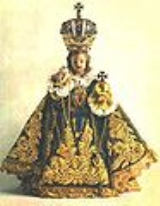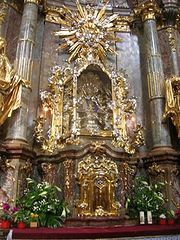
Infant Jesus of Prague
Encyclopedia

Jesus
Jesus of Nazareth , commonly referred to as Jesus Christ or simply as Jesus or Christ, is the central figure of Christianity...
located in the Church of Our Lady Victorious
Church of Our Lady Victorious
The Church of Our Lady Victorious in Malá Strana, the "small side" of Prague is a Carmelite church and the home of the statue called the "Infant Jesus of Prague"....
in Malá Strana
Malá Strana
Malá Strana is a district of the city of Prague, Czech Republic, and one of its most historic regions.The name translated into English literally means "Little Side", though it is frequently referred to as "Lesser Town", "Lesser Quarter", or "Lesser Side"...
, Prague
Prague
Prague is the capital and largest city of the Czech Republic. Situated in the north-west of the country on the Vltava river, the city is home to about 1.3 million people, while its metropolitan area is estimated to have a population of over 2.3 million...
.
History
Its earliest history can be traced back to Prague in the year 1628 when the small, 19-inch (48 cm) high, wax statue of the Infant JesusChild Jesus
The Child Jesus represents Jesus from his Nativity to age 12. At 13 he was considered to be adult, in accordance with the Jewish custom of his time, and that of most Christian cultures until recent centuries.The Child Jesus is frequently depicted in art, from around the third or fourth century...
was given by Princess Polyxena von Lobkowicz
Lobkowicz
The Lobkowicz family is one of the oldest still existing Bohemian noble families dating back to the 14th century...
(1566-1642) to the Discalced Carmelites
Discalced Carmelites
The Discalced Carmelites, or Barefoot Carmelites, is a Catholic mendicant order with roots in the eremitic tradition of the Desert Fathers and Mothers...
, to whom she had become greatly attached. The princess had received the statue as a wedding gift (1603) from her mother, María Manrique de Lara y Mendoza, a Spanish noblewoman, to whom it had been a wedding gift in Spain (1555) and who had brought it to Bohemia
Bohemia
Bohemia is a historical region in central Europe, occupying the western two-thirds of the traditional Czech Lands. It is located in the contemporary Czech Republic with its capital in Prague...
. An old legend in the Lobkowicz family insists that Doña María had been given the statue by St Teresa of Avila herself.
Upon presenting it, the pious princess Polyxena is said to have uttered a prophetic statement to the religious: "Venerable Fathers, I bring you my dearest possession. Honour this image and you shall never want". The statue was placed in the oratory
Oratory (worship)
An oratory is a Christian room for prayer, from the Latin orare, to pray.-Catholic church:In the Roman Catholic Church, an oratory is a structure other than a parish church, set aside by ecclesiastical authority for prayer and the celebration of Mass...
of the monastery of Our Lady of Victory, Prague, where special devotions to Jesus were offered before it twice a day. Carmelite novice
Novice
A novice is a person or creature who is new to a field or activity. The term is most commonly applied in religion and sports.-Buddhism:In many Buddhist orders, a man or woman who intends to take ordination must first become a novice, adopting part of the monastic code indicated in the vinaya and...
s voluntarily vow themselves to poverty, and here they professed their poverty in the presence of the Divine Infant.
Upon hearing of the Carmelites' devotions and needs, the Emperor Ferdinand II
Ferdinand II, Holy Roman Emperor
Ferdinand II , a member of the House of Habsburg, was Holy Roman Emperor , King of Bohemia , and King of Hungary . His rule coincided with the Thirty Years' War.- Life :...
of the House of Habsburg sent along 2,000 Florins and a monthly stipend
Stipend
A stipend is a form of salary, such as for an internship or apprenticeship. It is often distinct from a wage or a salary because it does not necessarily represent payment for work performed, instead it represents a payment that enables somebody to be exempt partly or wholly from waged or salaried...
for their support.
In 1630, the Carmelite novitiate
Novitiate
Novitiate, alt. noviciate, is the period of training and preparation that a novice monastic or member of a religious order undergoes prior to taking vows in order to discern whether they are called to the religious life....
was transferred to Munich
Munich
Munich The city's motto is "" . Before 2006, it was "Weltstadt mit Herz" . Its native name, , is derived from the Old High German Munichen, meaning "by the monks' place". The city's name derives from the monks of the Benedictine order who founded the city; hence the monk depicted on the city's coat...
. With the transfer of novices, Prague lost its most ardent devotees of the Infant. Disturbances in Bohemia
Bohemia
Bohemia is a historical region in central Europe, occupying the western two-thirds of the traditional Czech Lands. It is located in the contemporary Czech Republic with its capital in Prague...
due to the Thirty Years War brought an end to the special devotions, and on November 15, 1631, the army of King Gustavus Adolphus of Sweden
Gustavus Adolphus of Sweden
Gustav II Adolf has been widely known in English by his Latinized name Gustavus Adolphus Magnus and variously in historical writings also as Gustavus, or Gustavus the Great, or Gustav Adolph the Great,...
took possession of the churches of Bohemia's capital city. The Carmelite friary was plundered by the Lutheran
Lutheranism
Lutheranism is a major branch of Western Christianity that identifies with the theology of Martin Luther, a German reformer. Luther's efforts to reform the theology and practice of the church launched the Protestant Reformation...
Swedes, and the image of the Infant of Prague was thrown into a pile of rubbish behind the altar
Altar
An altar is any structure upon which offerings such as sacrifices are made for religious purposes. Altars are usually found at shrines, and they can be located in temples, churches and other places of worship...
. Here it lay forgotten, its hands broken off, for seven years, until it was found again in 1637 by Father Cyrillus and placed in the church's oratory. One day, while praying before the statue, Father Cyrillus claimed to have heard a voice say, "Have pity on me, and I will have pity on you. Give me my hands, and I will give you peace. The more you honor me, the more I will bless you." Since then, the statue has remained in Prague and has drawn many devotees worldwide to go and honor the Holy Child. Claims of blessings, favors and miraculous healings have been made by many who petitioned before the Infant Jesus. Statuettes of the Infant Jesus are placed inside many Catholic churches, sometimes with the quotation, "The more you honor me, the more I will bless you."
A copy of this statuette is placed in the University Chapel in Naples
Naples
Naples is a city in Southern Italy, situated on the country's west coast by the Gulf of Naples. Lying between two notable volcanic regions, Mount Vesuvius and the Phlegraean Fields, it is the capital of the region of Campania and of the province of Naples...
, Italy
Italy
Italy , officially the Italian Republic languages]] under the European Charter for Regional or Minority Languages. In each of these, Italy's official name is as follows:;;;;;;;;), is a unitary parliamentary republic in South-Central Europe. To the north it borders France, Switzerland, Austria and...
with the information on the original Prague's statuette.

Europe
Europe is, by convention, one of the world's seven continents. Comprising the westernmost peninsula of Eurasia, Europe is generally 'divided' from Asia to its east by the watershed divides of the Ural and Caucasus Mountains, the Ural River, the Caspian and Black Seas, and the waterways connecting...
in the Middle Ages
Middle Ages
The Middle Ages is a periodization of European history from the 5th century to the 15th century. The Middle Ages follows the fall of the Western Roman Empire in 476 and precedes the Early Modern Era. It is the middle period of a three-period division of Western history: Classic, Medieval and Modern...
.
Devotion
Today, thousands of pilgrims pay homage to the Infant of Prague every year. The tradition of the Infant Jesus processionProcession
A procession is an organized body of people advancing in a formal or ceremonial manner.-Procession elements:...
and the coronation continues to this day. This ceremony is the closing highlight of the annual Feast of the Infant Jesus in Prague.
In the past in Ireland
Ireland
Ireland is an island to the northwest of continental Europe. It is the third-largest island in Europe and the twentieth-largest island on Earth...
some brides would place an Infant of Prague statue outside their house the night before their wedding. This was meant to ensure that there would be good weather for the wedding day.http://www.irishcultureandcustoms.com/ACustom/InfantPrague.html
Once every four years, two wooden statues of Infant Jesus made in Prague are sent to various Catholic churches of the world. In India, the Infant Jesus Shrine in Bangalore and the Saint Theresa Church Perambur
Saint Theresa Church Perambur
St.Theresa Church is under the archdiocese of Madras-Mylapore in Tamilnadu. located in Sembiam division of Perambur, Chennai. Approximately 900 families have the membership in this Catholic parish. Many people from various parts of Chennai pilgrimage to this church for the devotion of Infant Jesus...
(Chennai) obtain one each of these statues.
See also
- Infant Jesus
- Santo Niño de CebuSanto Niño de CebuThe Santo Niño de Cebú is a Roman Catholic figure of the Child Jesus highly similar to the Infant Jesus of Prague. Like the image's counterpart in Prague, the figure is clothed in expensive textile robes mostly donations from fervent devotees in the Philippines and abroad...
- Santo Niño de AtochaSanto Niño de AtochaThe Santo Niño de Atocha is a Roman Catholic depiction of the Child Jesus and is popular in the Hispanic cultures of Spain, Mexico, Philippines and the southwestern United States, especially New Mexico.-History:...
- Holy Infant of Good HealthHoly Infant of Good HealthThe Holy Infant of Good Health is a statue of the Christ Child regarded by many to be miraculous, which was found in 1939, in Morelia , Mexico. The statue is eleven inches tall and has apparently been responsible for many healings. The veneration of the statue was approved by Luis M. Altamirano y...
- House of Lobkowicz
- Niño Jesús de Mula or Niño Jesús de Balate

